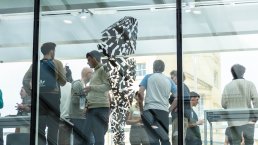Cascading Principles - a major mathematically inspired art exhibition by Conrad Shawcross - extended until June 2026
Oxford Mathematics is delighted to be hosting one of the largest exhibitions by the artist Conrad Shawcross in the UK. The exhibition, Cascading Principles: Expansions within Geometry, Philosophy, and Interference, brings together over 40 of Conrad's mathematically inspired works from the past seventeen years. Rather than in a gallery, they are placed in the working environment of the practitioners of the subject that inspired them, namely mathematics.
Conrad Shawcross models scientific thought and reasoning within his practice. Drawn to mathematics, physics, and philosophy from the early stages of his artistic career, Shawcross combines these disciplines in his work. He places a strong emphasis on the nature of matter, and on the relativity of gravity, entropy, and the nature of time itself. Like a scientist working in a laboratory, he conceives each work as an experiment. Modularity is key to his process and many works are built from a single essential unit or building block. If an atom or electron is a basic unit for physicists, his unit is the tetrahedron.
Unlike other shapes, a tetrahedron cannot tessellate with itself. It cannot cover or form a surface through its repetition - one tetrahedron is unable to fit together with others of its kind. Whilst other shapes can sit alongside one another without creating gaps or overlapping, tetrahedrons cannot resolve in this way. Shawcross’ Schisms are a perfect demonstration of this failure to tessellate. They bring twenty tetrahedrons together to form a sphere, which results in a deep crack and ruptures that permeate its surface. This failure of its geometry means that it cannot succeed as a scientific model, but it is this very failure that allows it to succeed as an art work, the cracks full of broad and potent implications.
The show includes all Conrad's manifold geometric and philosophical investigations into this curious, four-surfaced, triangular prism to date. These include the Paradigms, the Lattice Cubes, the Fractures, the Schisms, and The Dappled Light of the Sun. The latter was first shown in the courtyard of the Royal Academy and subsequently travelled all across the world, from east to west, China to America.
The show also contains the four Beacons. Activated like a stained-glass window by the light of the sun, they are composed of two coloured, perforated disks moving in counter rotation to one another, patterning the light through the non-repeating pattern of holes, and conveying a message using semaphoric language. These works are studies for the Ramsgate Beacons commission in Kent, as part of Pioneering Places East Kent.
The exhibition Cascading Principles: Expansions within Geometry, Philosophy, and Interference is curated by Fatoş Üstek, and is organised in collaboration with Oxford Mathematics.
The exhibition is open 9am-5pm, Monday to Friday. Some of the works are in the private part of the building and we shall be arranging regular tours of that area. If you wish to join a tour please email @email.
The exhibition runs until 30 June 2026. You can see and find out more here.
Watch the four public talks centred around the exhibition (featuring Conrad himself).
The exhibition is generously supported by our longstanding partner XTX Markets.
Images clockwise from top left of Schism, Fracture, Paradigm and Axiom




14:00
Springer Fibres - Geometrical and Combinatorial Applications
Abstract
Fibres coming from the Springer resolution on the nilpotent cone are incredibly rich algebraic varieties that have many applications in representation theory and combinatorics. Though their geometry can be very difficult to describe in general, in type A at least, their irreducible components can be described using standard Young tableaux, and this can help describe their geometry in small dimensions. In this talk, I will report on recent and ongoing work with Lewis Topley and separately Daniele Rosso on geometrical and combinatorial applications of the classical ‘type A’ Springer fibres and the ‘exotic’ type C Springer fibres coming from Kato’s exotic Springer correspondence.
Continuous Linear Endomorphisms of Holomorphic Functions
Abstract
Let $X$ denote an open subset of $\mathbb{C}^d$, and $\mathcal{O}$ its sheaf of holomorphic functions. In the 1970’s, Ishimura studied the morphisms of sheaves $P\colon\mathcal{O}\to\mathcal{O}$ of $\mathbb{C}$-vector spaces which are continuous, that is the maps $P(U)\colon\mathcal{O}(U)\to\mathcal{O}(U)$ on the sections are continuous. In this talk, we explain his result, and explore its analogues in the non-Archimedean world.
Realising The Smooth Representations of GL(2,Zp)
Abstract
The character table of GL(2,Fq), for a prime power q, was constructed over a century ago. Many of these characters were determined via the explicit construction of a corresponding representation, but purely character-theoretic techniques were first used to compute the so-called discrete series characters. It was not until the 1970s that Drinfeld was able to explicitly construct the corresponding discrete series representations via l-adic étale cohomology groups. This work was later generalised by Deligne and Lusztig to all finite groups of Lie type, giving rise to Deligne-Lusztig theory.
In a similar vein, we would like to construct the representations affording the (smooth) characters of compact groups like GL(2,Zp), where Zp is the ring of p-adic integers. Deligne-Lusztig theory suggests hunting for these representations inside certain cohomology groups. In this talk, I will consider one such approach using a non-archimedean analogue of de Rham cohomology.
On quivers, Auslander algebras and derived equivalences
Abstract
Auslander-Reiten theory provides lots of powerful tools to study algebras of finite representation type. One of these is Auslander correspondence, a well-known result establishing a bijection between the class of algebras of finite representation type and their corresponding Auslander algebras. I will present these classical results in a key example: the class of algebras associated to quivers of type A_n. I will talk about well-known results regarding their derived equivalence with another class of algebras, and I will present a more recent result regarding the perfect derived category of the Auslander algebras of type A_n.
Growth of Mod p Representations of p-adic Lie Groups
Abstract
The canonical dimension is a fundamental integer-valued invariant that is attached to mod p representations of p-adic Lie groups. I will explain why it is both an asymptotic measure of growth, and an algebraic quantity strongly related to Krull dimension. We will survey algebraic tools that can be applied in its calculation, and describe results spanning the last twenty years. I'll present a new theorem and suggest its possible significance for the mod p local Langlands programme.
Short Talks from Algebra PhD Students
A collection of bite-size 10-15 minute talks from current DPhil students in the Algebra group. The talks will be accessible to masters students and above.
With plenty of opportunity to chat to current students about what doing a PhD in algebra and representation theory is like!

